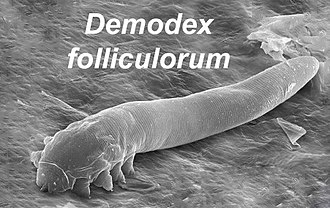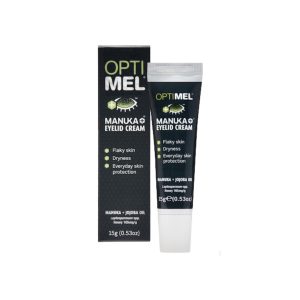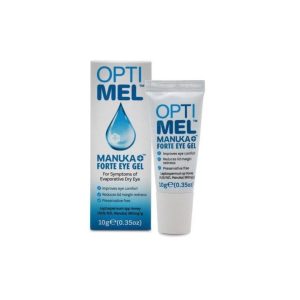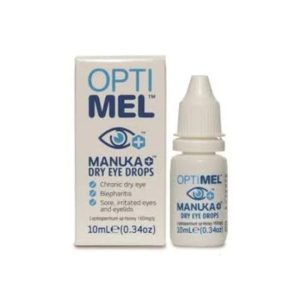Are you facing ongoing issues with persistent dryness, irritation, or discomfort in your eyes? If so, you might be among the many individuals dealing with a chronic dry eye condition that could be related to Demodex mites. These tiny, eight-legged organisms are a natural component of the human skin biome, particularly around the delicate areas of the eyes and eyelids. However, when their numbers exceed normal levels, it can lead to significant inflammation and exacerbate the symptoms associated with dry eye syndrome, resulting in major discomfort and irritation.
If you have been experiencing persistent unexplained dry eye symptoms, it’s crucial to explore the possibility that Demodex mites may be influencing your situation. In this comprehensive guide, we will help you identify the signs indicative of a Demodex infestation, clarify the connection between these mites and dry eye disease, and present effective treatment methods to help control their population and relieve your discomfort.

Recognizing the Distinct Symptoms of Demodex Blepharitis
Individuals affected by Demodex Blepharitis or an excess of these mites often report a variety of noticeable symptoms. Common signs include:
- Experiencing burning, stinging, or gritty sensations in the eyes, particularly noticeable towards the end of the day.
- Unexplained excessive tearing or watery eyes that are not attributed to allergies.
- Red, inflamed eyelids accompanied by irritation of the skin surrounding the eyes.
- Crusty, dandruff-like buildup along the lashes and lid margins, often appearing as collarettes.
- Extreme sensitivity to light, causing a constant squinting sensation.
- Episodes of blurred vision that fluctuate throughout the day.
Many individuals endure these dry eye symptoms for extended periods without recognizing that an infestation of Demodex mites may be a significant underlying cause. Identifying these symptoms is a critical step toward effectively addressing the root issue and improving your eye health.

Understanding How Demodex Mites Lead to Discomfort in Dry Eyes
Are you curious about how these minuscule creatures can cause such distressing dry eye symptoms? Demodex mites thrive on the oils and cellular debris present on the skin, especially within the hair follicles of your eyelashes. As they feed, they leave behind waste products, eggs, and remnants of deceased mites, which accumulate along the lid margins. This buildup creates a thick layer of debris and a bacterial biofilm that can obstruct the delicate oil glands essential for maintaining optimal eye health.
When these oil glands fail to release adequate oils, it leads to the rapid formation of dry patches on the eye's surface. This oily tear film is crucial for preventing the quick evaporation of the watery tears that keep our eyes moist and comfortable. The inflammation caused by the blockage can further intensify eye irritation, redness, and the uncomfortable gritty sensation commonly associated with dry eye conditions.
Exploring the Life Cycle of Demodex Mites for Targeted Treatment
Gaining insight into the life cycle of Demodex mites is essential for implementing effective treatment strategies. These mites undergo distinct stages: egg, larva, nymph, and adult, over a life cycle that lasts approximately 14 to 21 days. They are most active during the night, emerging from their hair follicles to mate and lay new eggs on the skin's surface.
This nocturnal behavior suggests that the most effective time to apply Demodex treatments is during the evening, just before bedtime. By targeting the mites when they are most active, you can significantly enhance the effectiveness of your treatment. However, due to their rapid reproductive capabilities, any surviving mites can quickly repopulate, emphasizing the necessity for continuous treatment over several weeks or even months to achieve long-lasting results.
Effective Strategies for Managing Demodex-Related Dry Eye Conditions
If your optometrist validates a high count of Demodex mites through eyelash sampling or microscopic examination, they may recommend a variety of treatment options to combat the infestation:
1. Harnessing the Power of Tea Tree Oil Eyelid Wipes and Scrubs for Relief
Formulations containing tea tree oil are renowned for their powerful antimicrobial and antiparasitic properties, making them exceptionally effective in eliminating mites. These products can effectively remove surface mites, dissolve collarettes caused by these pests, and help draw out buried mites, rendering them more susceptible to treatment.
While tea tree oil is highly effective against mites, it can cause stinging upon application and may be cytotoxic to healthy cells, potentially inflaming and exacerbating symptoms for some patients.
Regularly applying tea tree oil eyelid wipes or scrubs before bedtime can gradually reduce the mite population. A notable example of a potent tea tree oil treatment is OcuSoft Oust Foam, specifically designed for managing blepharitis primarily caused by Demodex mites.
2. Utilizing Gentle Hypochlorous Acid Lid Hygiene Sprays for Safe Eye Care
Hypochlorous acid is a naturally occurring substance produced by our immune system and serves as an effective antimicrobial agent. It is gentle on the eyes, does not cause stinging, and is safe for our cells.
Disinfecting lid sprays and cleansing foams containing hypochlorous acid not only eliminate mites but also help reduce inflammation and alleviate symptoms. Applying these solutions to the lash lines before bed can effectively remove mites and their debris. Many of these products have a unique odor reminiscent of chlorinated pool water. Popular hypochlorous acid-based solutions include Ocusoft Hypochlor Spray and Avenova.
Among these, Ocusoft Hypochlor Foam is often favored due to its superior value and extended shelf life after opening, making it a practical choice for ongoing management.
3. Exploring the Benefits of Manuka Honey Solutions for Eye Health
Recent studies suggest that Manuka Honey solutions may be comparably effective as 50% tea tree oil against Demodex, although further research is warranted in this area. While it may induce a slight sting upon application, Manuka Honey is generally less irritating than tea tree oil and demonstrates excellent efficacy against other forms of blepharitis. It is non-cytotoxic and less likely to trigger inflammation in the eyelids.
Numerous patients report that any initial sting is well worth it, as they often experience significant relief afterward. Manuka Honey solutions are available in gel form (like Optimel Forte, which is more effective but may sting more) and as drops (such as Optimel Drops, which are easier to apply and sting less).
4. Managing Severe Demodex Infestations with Prescription Anti-Parasitics
In cases where Demodex overpopulation is particularly severe and persistent, healthcare professionals may opt to prescribe oral antiparasitic medications. For instance, formulations such as Ivermectin in pill form have shown effectiveness in managing these infestations. Additionally, weekly doses of oral tea tree oil supplements taken over several months can help maintain mite levels under control and provide longer-lasting relief.
5. Exploring Advanced Professional Treatments for Demodex Management
Some eye care clinics provide intensive in-office treatments specifically designed for Demodex management, utilizing specialized products like Oust Demodex Cleanser Swabstix or a handheld electric brush known as BlephEx.
The Oust Demodex Cleanser Swabstix offers targeted treatment options that can effectively assist in alleviating the impact of these bothersome mites.
The Article: Demodex Mites Linked to Chronic Dry Eye Issues first appeared on https://writebuff.com.
The Article Demodex Mites and Their Connection to Chronic Dry Eye Was Found On https://limitsofstrategy.com





It’s interesting to see more discussion around Demodex mites and their connection to dry eye syndrome. I’ve personally struggled with dry eyes for years, and it often felt like a never-ending cycle of discomfort without a clear explanation. Learning about the potential role of these tiny mites is quite enlightening, as they have been relatively overlooked in many discussions about eye health.
It’s really fascinating how something as tiny as Demodex mites can have a significant impact on eye health. I totally get the feeling of being caught in that cycle of discomfort with dry eyes—it’s frustrating when you don’t have a clear cause. I’ve also read some studies that suggest these mites can contribute to inflammation, which might explain why the discomfort sometimes seems relentless.
I can relate to the frustration of dealing with dry eyes, and I recently came across some helpful makeup tips specifically for sensitive skin that might just make a difference in your routine.
‘Makeup Tips for Sensitive Skin: Cosmetics for Dry Eyes’
https://soonrs.com/makeup-tips-for-sensitive-skin-cosmetics-for-dry-eyes/.
It’s interesting how interconnected our skin health and overall well-being are, isn’t it? Demodex mites certainly don’t look like much under a microscope, but their influence on conditions like dry eyes and inflammation can be pretty significant. Those tiny creatures can really stir up some issues, often without us even realizing it. It’s a complex relationship—these mites are natural inhabitants of our skin, but when their numbers grow too large, they can lead to discomfort and complications.
It’s interesting how such small creatures can wield such a profound effect on our eye health. I think many people don’t realize just how interconnected our body systems are, particularly when it comes to skin and eye health. The cycle of discomfort with dry eyes can feel relentless, especially when you don’t have a clear explanation for it. With conditions like dry eye syndrome, the frustration often stems from a combination of factors, and the presence of Demodex mites is just one element in that puzzle.
It’s great to hear your thoughts on this topic. The connection between Demodex mites and dry eye syndrome is definitely gaining traction in the conversation around eye health. Many people, just like you, find themselves stuck in that cycle of discomfort without understanding the underlying causes.
Ah, the delightful world of Demodex mites—who knew these little critters had such a notorious reputation? I always thought dry eyes were just my body’s way of convincing me it’s time for more coffee or a solid excuse to nap. But no, it’s apparently a tiny army of eight-legged invaders conspiring against my comfort!
It’s pretty wild to think about, right? The idea that these tiny eight-legged mites might be causing us some discomfort is almost like something out of a sci-fi story, but here we are. I remember reading somewhere about how common Demodex mites are—most of us probably have them to some degree without even realizing it.
It’s fascinating to think about how something so small can go unnoticed in our daily lives, yet have such an impact on our well-being. Demodex mites are definitely more common than many realize; studies suggest that a large percentage of adults carry them on their skin, often without any symptoms.
It’s really interesting how these tiny creatures can be such a big part of our lives without us even realizing it. I think it’s a reminder of how much we don’t see on a daily basis that can still affect us. The fact that a large percentage of adults carry these mites without any symptoms adds another layer to our understanding of skin health. It makes me wonder about the balance our bodies keep with these microorganisms.
I appreciate your thoughts on this. It really is fascinating how much life exists at such a small scale and how it interacts with us every day, often without us noticing. These mites are a perfect example of nature’s balance; they play their part on our skin, and we often coexist peacefully. It raises interesting questions about our bodies’ immune responses and how adaptable we are to these small companions.